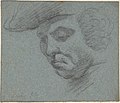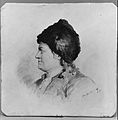Charles-Nicolas Cochin the Younger

Charles-Nicolas Cochin the Younger (born February 22, 1715 in Paris ; † April 29, 1790 ibid), also called Charles-Nicolas Cochin fils or Charles-Nicolas Cochin le jeune , was a French engraver and etcher .
biography
Cochin was the son of the engravers Louise-Magdeleine Horthemels and Charles-Nicolas Cochin the Elder . He grew up in the Rue Saint-Jacques , in the streets around St-Étienne-du-Mont , where his parents' house was. The engraving, which was always present in his parents' house, encouraged him to use the burin himself . He made his first etchings at the age of twelve. His interest in literature, science and languages was also remarkable. So he had taught himself Latin, Italian and English and read books in these languages.
His education then, under his demanding father, was difficult for him. The copying strained him and bored him. The exercises consisted in the reproduction of engravings after Hendrick Goltzius , Schelte a Bolswert (1586–1659) and François de Poilly the Elder. Ä. which should give him the necessary perseverance in his work with the burin. In doing so, however, he earned the hours that he could devote himself entirely to his pleasure of free work, preferably making etchings.
His increasingly solidified style earned him recognition early on. One of his early copies was not to become a fame sheet for him. The copy of La maîtresse d'école , based on his father's model, had completely failed. Unfortunately, he signed the sheet and that's how it went to press. Nevertheless, he received direct orders for the preparation of print templates early on. In 1729 Melchior de Polignac commissioned him with an oeuvre from the birth of Louis XV. , which Cochin created as an etching. This technique also became his calling.
In 1735, at the age of 20, Cochin made the first etching, le marchant joialier de Roi , based on his own design. This made him the first engraver who not only copied but also implemented his own designs. This talent had already shown itself in his childhood, when he drew and painted a lot, and it had matured further and further.
Cochin started his own workshop and engraved portraits, historical scenes and genres. The quality of his work was so good that he was encouraged by the king. His work was interrupted by a trip to Italy from 1749 to 1751, during which he accompanied the Marquis de Vandières and Jacques-Germain Soufflot . When he returned, he developed completely new subjects that were to influence all of his contemporaries.
At the instigation of the king, Cochin was applauded as a member of the Académie royale de peinture et de sculpture in 1751 , without having to submit a work or the obligatory two members who should have proposed him. He presented this work only in 1763.
After Antoine Coypel's death in 1752 he took over the office of archivist of the Académie and in 1755 he became a chronicler of the Académie. In 1757 he was raised to the nobility and awarded the Ordre de Saint-Michel in the same year . Charles André van Loo , the first royal painter and chairman of the Académie, won his rise and in 1761 Cochin was able to achieve that copper engraving was recognized as an independent art form.
He recorded all royal and ecclesiastical events of his time in copperplate engravings and thus became a chronicler of his time. Over 1500 of his works and a large number of letters have survived.
His word carried a lot of weight. He was a determined innovator and rejected the traditional baroque style. So it came to a scandal in 1667 when Jean-Baptiste Pigalle received the order for a sculpture from the king. Cochin even threatened to withdraw from the Académie and only Denis Diderot was able to dissuade him from this step.
How unusual Cochin was as an engraver was shown again in 1776 and 1777 when he made two trips to Normandy to make sketches of Le Havre and Rouen , which he later wanted to implement in his studio.
Cochin was never married because he had dedicated his life to his work. His student Simon-Charles Miger described his apartment as dreary. Miger also reported that his elderly mother and sister and cousin looked after him. After the death of his sister and later his mother, Cochin suffered more and more from loneliness that he did not know how to change. In his old age, Cochin complained in letters that he wrote in 1780 and 1781, his suffering about outstanding pension payments, which the current King Louis XVI. debt.
His cousin, son of Alexis Simon Belle and Marie-Nicole Horthemels , was his executor.
Works (excerpt)
- Lycurgue blessé in une sédition
- La Mort d'Hippolyte
- David jouant de la harpe devant Saül
- Figures de la Jérusalem délivrée
- Vue perspective de la décoration élevée sur la terrasse du château de Versailles pour l'illumination et le feu d'artifice qui a été tiré à l'occasion de la naissance de duc de Bourgogne on December 30, 1751, engraved after his design by Martin Marvie
- Les Conquêtes de L'Empereur de la Chine (1766–1774),
- La Bénignite, engraved according to its design by François Robert Ingouf
- Le frontispice de l'Encyclopédie, engraved according to his design by Benoît-Louis Prévost
Drawing of Cochin for the procession to Memphis
Engraving by Benjamin Franklin of Cochin
literature
- Edmond and Jules de Goncourt : L'art du XVIIIe siècle. Série 2 , 1881-1882, Volume 3, pp. 327ff. digitized
- Charles-Antoine Jombert : Catalog de l'oeuvre de Ch. Nic. Cochin fils , 1770, digitized
Web links
- Information on Charles-Nicolas Cochin the Younger in the database of the Bibliothèque nationale de France .
| personal data | |
|---|---|
| SURNAME | Cochin, Charles-Nicolas the Younger |
| ALTERNATIVE NAMES | Cochin, Charles-Nicolas fils |
| BRIEF DESCRIPTION | French engraver and eraser |
| DATE OF BIRTH | February 22, 1715 |
| PLACE OF BIRTH | Paris |
| DATE OF DEATH | April 29, 1790 |
| Place of death | Paris |






